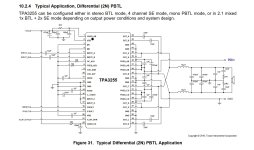Hi Guys, anybody who knows if this amplifiar can be bridged? or has one and can try?
Looking for a subwoofer amplifier and the A04 is a lot cheaper than the sub one that offers the filter that I don't need...
Thanks!
Looking for a subwoofer amplifier and the A04 is a lot cheaper than the sub one that offers the filter that I don't need...
Thanks!
I found this video that sais that the A07 is bridgeable...do you agree? Odd that they don't publicize it that way...thermal issues maybe?
The TPA3251 has four single ended (SE) outputs. In a stereo amplifier application like the Aiyima A04, these four SE outputs are configured as two bridged (BTL) pairs. In a mono amplifier application like the Aiyima A1001, these two BTL pairs are then further paralleled to produce one PBTL output.
I'm not sure what is happening in that video, but he definitely isn't bridging the two BTL outputs. In order to do that, he would need to invert the input to one channel (using a 1:1 audio transformer), then connect the single speaker between the two positive terminals - not between the positive of one channel & the negative of the other as we see him doing.
I'm actually curious myself as to whether the TPA3251 or TPA3255 can be (genuinely) bridged, as I have a mono 8Ω application I need a cheap, battery-powered amplifier for. My understanding is that the caveat of the PBTL configuration of these chips is that with an 8Ω load they will be drastically current limited, to the same output power as if you just connected that 8Ω load directly to one BTL pair rather than to all four SE outputs configured as PTBL.
Hopefully somebody more knowledgeable than us will be able to shine some light onto whether you can bridge two BTL amplifiers - which I guess would make it a 'BBTL' configuration? However I suspect there is a reason why PBTL is commonly seen & 'BBTL' is not.
I'm not sure what is happening in that video, but he definitely isn't bridging the two BTL outputs. In order to do that, he would need to invert the input to one channel (using a 1:1 audio transformer), then connect the single speaker between the two positive terminals - not between the positive of one channel & the negative of the other as we see him doing.
I'm actually curious myself as to whether the TPA3251 or TPA3255 can be (genuinely) bridged, as I have a mono 8Ω application I need a cheap, battery-powered amplifier for. My understanding is that the caveat of the PBTL configuration of these chips is that with an 8Ω load they will be drastically current limited, to the same output power as if you just connected that 8Ω load directly to one BTL pair rather than to all four SE outputs configured as PTBL.
Hopefully somebody more knowledgeable than us will be able to shine some light onto whether you can bridge two BTL amplifiers - which I guess would make it a 'BBTL' configuration? However I suspect there is a reason why PBTL is commonly seen & 'BBTL' is not.
Last edited:
That was my doubt...if he connects it in PBTL it still have its uses...from my limited competence it looks like you would be able to use it with a 2Ohm load that way...
I need to connect a 4Ohm subwoofer so I'll be better with a mono TPA3255 or an irs2092 anyway...
I need to connect a 4Ohm subwoofer so I'll be better with a mono TPA3255 or an irs2092 anyway...
The Aiyima A04 can't be used in PBTL because changing output mode requires the mode pins M1 & M2 on the TPA3251 chip to be connected differently.
But yes, the main benefit of PBTL as far as I'm aware is the ability to drive lower impedance loads.
But yes, the main benefit of PBTL as far as I'm aware is the ability to drive lower impedance loads.
Not really... the impedance a bridged amplifier sees is half so a 4 ohm speaker will appear as a 2 ohm load to a bridged amplifier. So its rather the opposite...
//
//
Each channel of a bridged amplifier sees half the impedance, but each channel of a paralleled amplifier sees double the impedance.
If you look at the datasheet, you'll see that the performance of each of the four SE outputs is given at 4 ohms, 3 ohms & 2 ohms.
For BTL where these SE outputs are bridged in pairs, the performance is given (as you expect) at 8 ohms, 6 ohms & 3 ohms.
However for PBTL where these BTL outputs are then further paralleled, the performance is given at 4 ohms, 3 ohms & 2 ohms.
If you connect a 2 ohm load in PBTL, each BTL sees 4 ohms (double) & then each SE sees 2 ohms (half).
If you look at the datasheet, you'll see that the performance of each of the four SE outputs is given at 4 ohms, 3 ohms & 2 ohms.
For BTL where these SE outputs are bridged in pairs, the performance is given (as you expect) at 8 ohms, 6 ohms & 3 ohms.
However for PBTL where these BTL outputs are then further paralleled, the performance is given at 4 ohms, 3 ohms & 2 ohms.
If you connect a 2 ohm load in PBTL, each BTL sees 4 ohms (double) & then each SE sees 2 ohms (half).
- Home
- Amplifiers
- Class D
- Is AIYIMA A04 (tpa3251) bridgeable?
